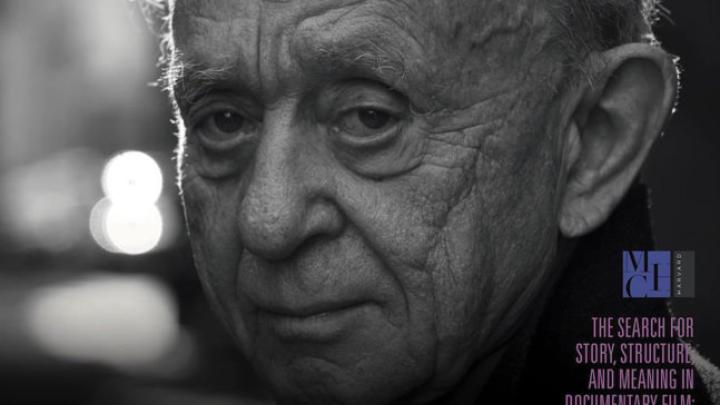Some weeks after the news that his entire filmography, some 50 documentaries in 50 years, would finally be widely available via streaming services, the director Frederick Wiseman came to Harvard and explained what kept him going.
“Documentary is fun!” he told his audience at Sanders Theatre. “Making these movies makes demands on your physical and mental resources…it makes demands on your whole being. For me, that's the fun.”
Since 1927, the Norton Lectures have brought luminaries in literature, music, art, and design to speak at Harvard, including T.S. Eliot, A.B. ’10, Litt.D. ’47, Charles Eames, Herbie Hancock, and most recently, Toni Morrison, Litt.D. ’89. Wiseman’s appearance on January 29 marked the first time in its 90-year history that the series has featured a filmmaker. (This year is also the first time the post, formally called the Norton professorship in poetry, has been split: French New Wave director Agnès Varda and Wim Wenders, associated with the New German Cinema, will speak later this spring.)
Wiseman is considered a chronicler of institutions: dance companies, schools for the deaf, various organs of local government. The most recent was the New York Public Library, in his 2017 film Ex Libris. The most notorious was Bridgewater State Hospital for the Criminally Insane, in Massachusetts, in Titicut Follies. That film, his first, was banned from general distribution until 1991; last year, he helped adapt the documentary into a ballet.
But the director is neither muckracker nor aesthete: Wiseman makes movies, simply, about places and the people in them. They’re often quite long, running for three or four hours each. Their titles are generally direct (Meat, Model, Missile, Central Park, High School), as is their observational style, unadorned by voiceover or scoring, Though they rarely have a conventional, easily summarized narrative, they do have structure: his films enforce a state of sitting still, of noticing. The viewer becomes absorbed in the granular texture of the setting, the little, particular moments that illuminate daily habits and collective patterns.
Wiseman’s talk was less lecture than brief tour through his work: he played clips and briefly explained how they reflect some aspect of his process. One major theme was the importance of waiting for, and then seizing, opportunity. For Law and Order (1968), a black-and-white documentary made for TV, he followed police in their daily rounds in Kansas City, Missouri. Wiseman sat in patrol cars for hours until it came time for his subjects to jump out and help a lost child or—as in the sequence he showed on Monday—kick down a door. The same principle applied to the much calmer In Jackson Heights, a 2015 film shot in digital color, its brightness almost jarring by contrast. That clip depicted a Southern Baptist church group, dressed in bright pink and on a mission to clean up the streets of Queens, New York, that is approached by a stranger. She asks them for a prayer.
“This scene, which started off as comedy, turned out to be very moving and sad,” commented Wiseman. “I found it just by looking.” He continued, “I don’t create these sequences—a big part of my job is to recognize them and figure out how to use them. And if this scene illustrates anything, it’s that you can sometimes count on the kindness of strangers.”
Wiseman also illustrated how he built structure within and between sequences, working with hundreds of hours of footage. Showing a clip from 1971’s Basic Training, about army recruits, he recalled being struck by the recruits’ graceful movements as they learned how to search for land-mines. “As soon as I had the idea for a dance, it helped me organize the sequence so that I could try and cut it from hand gesture to arm gesture,” scored by the “music” of the crickets chirping in the background.
Whether it was a town, hospital, or boxing gym, each place drew a boundary within which to study human activity, said Wiseman. After days or weeks of observation, he’d sort through the rushes and give them form. “Finding the film in the editing, I’m also fending off, at least temporarily, some of the chaos that I feel about my own experience, and the strangeness and wonder of living. Of daily life.” That wonder could just as easily be found among the cubicles of a welfare office (Welfare, 1975), the cells of a primate research center (Primate, 1974), or a class teaching immigrant taxi drivers mnemonics to remember which bridges have tolls (In Jackson Heights).
After the floor was opened for questions from the audience, Wiseman often brushed them off, saying he didn’t like to speak in generalities. As the hour wore on, this became something of a joke: “I hope you’ll want to answer this,” one participant said, sheepishly, stepping up to the microphone.
But the director wasn’t playing coy, either. Mostly, he seemed to want to resist making grand pronouncements. Wiseman wasn’t out to make his craft seem mystical. There was no special trick to getting access to spaces, or permissions to film, he claimed—“My big secret is that I ask.” Later, he insisted that he didn’t think the camera, or his presence, overly altered subjects’ behavior: “People are distracted by my big ears.” And he has never done much advance research or preparation before a shoot. Just showing up and spending time with people would yield something interesting. “I don't go to Las Vegas,” he said. “I’m a gambler with the movies.”
Asked his favorite book, though, he answered immediately: Herman Melville’s The Confidence Man, which he called a “contemporary novel” from 1857. “It’s the book that most accurately reflects what's going on.”
Wiseman will appear at the Harvard Film Archive’s February 4 screening of Near Death, which takes place at an intensive care unit at a Boston hospital—and which, at 358 minutes, is his longest film. The following afternoon, on February 5, he will deliver his second, and final, lecture.








